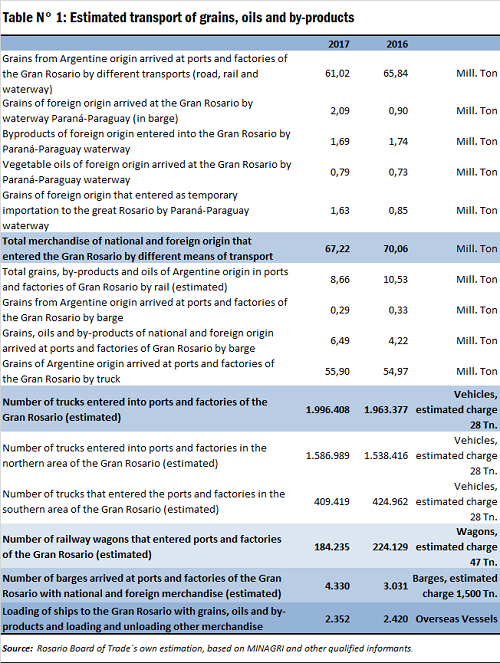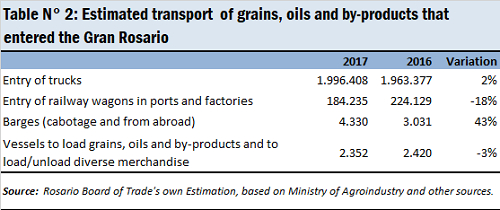The estimations referred to the movement of grains, oils and by-products that arrived in 2017 to the port terminals and factories of the Gran Rosario, either to be industrialized and/or exported, show an increase in the entrance of trucks to the port area, of approximately 30,000 additional trucks compared to the previous year. According to our estimates, in 2017, approximately 1,990,000 trucks, 184,000 railroad wagons and 4,300 barges would have entered the Gran Rosario. To this enormous movement of transport must be added the entry of about 2,350 vessels that enter the Gran Rosario to look for grains, oils and by-products and to load/unload goods of different nature and origin: fertilizers, containers, minerals, etc.
Based on the figures of shipments abroad through overseas vessels, we estimate that during 2017, about 61 million tons of grains of Argentine origin arrived at the factories and ports of the Gran Rosario. This merchandise entered using trucks, railroad wagons and barges.
In addition, 1,630,000 tons of grains, 1,690,000 tons of meal and 790,000 tons of Paraguayan and Bolivian oils entered the ports on their way to be exported, to which we must add 1,630,000 tons of temporary grain imports. In this case it is merchandise entered into barges by the Paraná-Paraguay waterway to the port terminals of the Gran Rosario.
According to figures from the Ministry of Agribusiness, the shipments of grains, by-products and oils abroad through the port terminals of the Gran Rosario increased by 1.3% in 2017 compared to the previous year. They were close to 69 million tons in 2017 out of a total of 86.5 million. This implied - for the Gran Rosario - an increase in merchandise of Argentine origin transported by truck, although the same would not have happened with the barges and railroad wagons transport of Argentine merchandise.
Let's analyze now the total number of trucks that could have entered the northern and southern areas of the Gran Rosario, in order to evaluate the transportation flows to these areas. From the methodological point of view, the terminals classified in the category "South Zone of the Gran Rosario" are those located on the Paraná River to the south from Rosario to Arroyo Seco. Such is the case of Servicios Portuarios S.A. which operates Unit VI and VII, Cargill in Villa Gobernador Gálvez and Punta Alvear, Dreyfus in General Lagos and ADM Agro in Arroyo Seco. Those of the "North Zone of the Gran Rosario" are all located towards the north of the city of Rosario and include those located in the cities of San Lorenzo, Puerto General San Martín and Timbúes. They are Molinos (San Benito), Vicentín and ACA in the city of San Lorenzo; Bunge (Pampa and Dempa docks), ADM Agro (Transit), Cofco (ex-Nidera), Cargill, and Terminal 6 S.A. in Puerto General San Martín; Dreyfus, Cofco and Renova S.A., in Timbúes.
According to the data provided by the grain suppliers, 79.5% of the trucks arrived in the northern area of the Gran Rosario, while the remaining 20.5% did so in the south. Unfortunately, we do not have similar information to know the areas of destination of the rail transport.
Regarding the rail flow to the Gran Rosario, an average load per wagon of 47 tons has been assumed. On this assumption the number of wagons would have reached 184,000.
According to the information prepared by the National Commission for Transport Regulation (CNRT), the transport of grains, agricultural by-products and oils throughout the Argentine rail system would have decreased by almost 6% in 2017 compared to 2016.
As regards the barges, about 6.5 million grains, oils and byproducts of national and foreign origin would have arrived in the Gran Rosario using this means of transport by the Paraná-Paraguay Waterway. An average load per barge of 1,500 tons has been assumed in this report. Consequently, the number of barges that would have entered the Great Rosary would be in the order of the 4,330 artifacts. The growth in the number of barges in 2017 has been remarkable: 42% in one year. Recall that in 2016 we had estimated the number of barges entered into the Gran Rosario in 3,030. The almost 1,300 additional barges are due to the strong growth of cargo arrivals from Paraguay and Bolivia, both for its final export shipment and for the volumes of soy bean that arrived under the temporary import regime. The cabotage charges for the Paraná River are still very low, 1e estimate them at 290 thousand tons.
According to our estimates, the percentage share of each means of transport, for the Argentine merchandise that arrives to the Gran Rosario, would have been approximately 86% for trucks, 13.5% for railroad and 0.5% for barges.
In the 1,990,000 trucks in the year that would have arrived at the Gran Rosario, we are not considering other truck movements such as those that transport biodiesel to oil refineries or those that carry vegetable oils to biodiesel plants. We also remember that other trucks with fuels, fertilizers, containers and other loads that have not been considered in our calculation circulate through the Gran Rosario.Finally, according to our calculations, the entry of ships to the port terminals of the southern area of the Gran Rosario (Rosario to Arroyo Seco) and north (San Lorenzo to Timbúes) during the year 2017 amounted to 2,352, which is 2.8 % less than the year 2016, that had been 2,420 vessels. Consequently, in 2017, 68 vessels overseas would have arrived in the Grand Rosario less than in 2016. This includes overseas vessels that enter these ports but exclude naval artifacts that carry out cabotage trips and the barges themselves. Also, in that total, the ship's entry to each terminal is computed, therefore it is counted by two when the same ship (during the same trip) loads in two terminals of the Up River Paraná. It should also be noted that the total number of ships entered include those that come to load or unload other types of cargo that are not grains, by-products and oils, such as minerals, general cargo, containers, etc.
Taking into account what was stated in the last part of the previous paragraph, if it is estimated that 90% of the vessels entered did so to load grains, by-products and vegetable oils, around 2,120 vessels would have entered for this purpose, which would imply an average load of about 32,300 tons per vessel, slightly higher than the average of 31,000 tons in 2016.
As we can see, the quantity of merchandise shipped abroad continues to grow through the port terminals of the Gran Rosario. To get an idea of the enormous magnitude of this increase, it can be pointed out that it has been 24% if we compare the year 2017 with 2008 and almost 100% if the comparison is with the year 2000.
